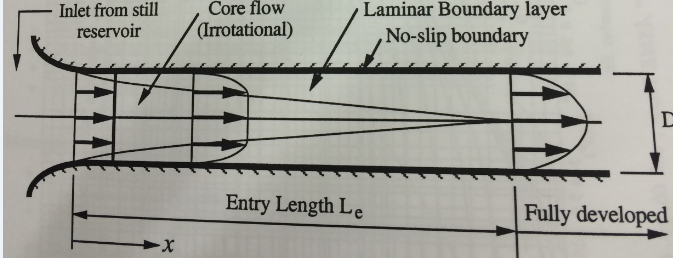(a) Water flows into a smooth pipe from a large, still reservoir, as shown in Figure. The pipe entrance is rounded with a large radius to prevent separation. The boundary layer on the inside of the pipe is laminar, and it thickens with streamwise distance x. Classical theory tells us that the entry length for laminar flow in such a pipe is given as follows:
Le/D = 0.06 ReD for ReD < 2300
Making appropriate assumptions, use boundary layer theory to confirm that this result is reasonable. Discuss the validity of any assumptions you make.
Discuss whether, in this analysis, you should use the 99% thickness, the momentum thickness or the displacement thickness.
(b) A new passenger aircraft is cruising as 360 km/h in still air. The aircraft's fuselage is 50m long, has a circular cross-section of nearly constant diameter, and has a surface area of 740m2. The aircraft's surface has a roughness height (e) of 1.0 mm.
(i) Determine whether laminar-to-turbulent transition occurs in the boundary layer of the fuselage. If transition occurs, where does it occur?
(ii) Estimate the 99% thickness (δ) of the boundary layer at the downstream end of the fuselage.
(iii) Estimate the skin friction drag on the aircraft's fuselage.
(iv) Estimate the skin friction drag on the fuselage if the boundary layer is laminar everywhere. Note: Flat plate drag coefficient data are plotted in Figure 6 at the end of this question paper.

Figure:Pipe entry region